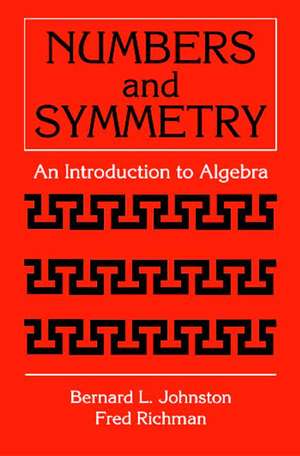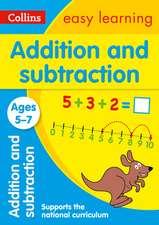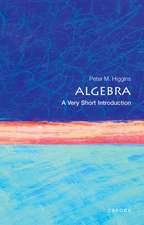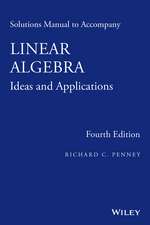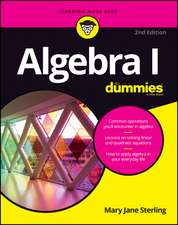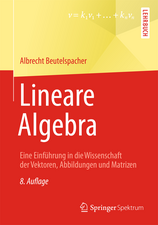Numbers and Symmetry: An Introduction to Algebra
Autor Bernard L. Johnston, Fred Richmanen Limba Engleză Paperback – 7 ian 1997
Designed for a typical one-semester undergraduate course in modern algebra, it provides a gentle introduction to the subject by allowing students to see the ideas at work in accessible examples, rather than plunging them immediately into a sea of formalism. The student is involved at once with interesting algebraic structures, such as the Gaussian integers and the various rings of integers modulo n, and is encouraged to take the time to explore and become familiar with those structures.
In terms of classical algebraic structures, the text divides roughly into three parts:
| Toate formatele și edițiile | Preț | Express |
|---|---|---|
| Paperback (1) | 490.96 lei 6-8 săpt. | |
| CRC Press – 7 ian 1997 | 490.96 lei 6-8 săpt. | |
| Hardback (1) | 1014.74 lei 6-8 săpt. | |
| CRC Press – 21 aug 2017 | 1014.74 lei 6-8 săpt. |
Preț: 490.96 lei
Preț vechi: 577.59 lei
-15% Nou
Puncte Express: 736
Preț estimativ în valută:
93.96€ • 102.02$ • 78.92£
93.96€ • 102.02$ • 78.92£
Carte tipărită la comandă
Livrare economică 22 aprilie-06 mai
Preluare comenzi: 021 569.72.76
Specificații
ISBN-13: 9780849303012
ISBN-10: 084930301X
Pagini: 270
Ilustrații: illustrations
Dimensiuni: 156 x 234 x 15 mm
Greutate: 0.5 kg
Ediția:1
Editura: CRC Press
Colecția CRC Press
ISBN-10: 084930301X
Pagini: 270
Ilustrații: illustrations
Dimensiuni: 156 x 234 x 15 mm
Greutate: 0.5 kg
Ediția:1
Editura: CRC Press
Colecția CRC Press
Public țintă
UndergraduateCuprins
1 New numbers -- 1.1 A planeful of integers, Z[i] -- 1.2 Circular numbers, Zn -- 1.3 More integers on the number line, Z [V] -- 1.4 Notes -- 2 The division algorithm -- 2.1 Rational integers -- 2.2 Norms -- 2.2.1 Gaussian integers -- 2.2.2 Z[V2] -- 2.3 Gaussian numbers -- 2.4 Q (V2) -- 2.5 Polynomials -- 2.6 Notes -- 3 The Euclidean algorithm -- 3.1 Bezout’s equation -- 3.2 Relatively prime numbers -- 3.3 Gaussian integers -- 3.4 Notes. -- 4 Units -- 4.1 Elementary properties -- 4.2 Bezout’s equation -- 4.2.1 Casting out nines -- 4.3 Wilson’s theorem -- 4.4 Orders of elements: Fermat and Euler -- 4.5 Quadratic residues -- 4.6 Z[\ /2) -- 4.7 Notes -- 5 Primes -- 5.1 Prime numbers -- 5.2 Gaussian primes -- 5.3 Z [s /2] -- 5.4 Unique factorization into primes. -- 5.5 Zn. -- 5.6 Notes -- 6 Symmetries -- 6.1 Symmetries of figures in the plane -- 6.2 Groups -- 6.2.1 Permutation groups -- 6.2.2 Dihedral groups -- 6.3 The cycle structure of a permutation -- 6.4 Cyclic groups -- 6.5 The alternating groups -- 6.5.1 Even and odd permutations -- 6.5.2 The sign of a permutation -- 6.6 Notes -- 7 Matrices -- 7.1 Symmetries and coordinates -- 7.2 Two-by-two matrices -- 7.3 The ring of matrices -- 7.4 Units -- 7.5 Complex numbers and quaternions -- 7.6 Notes -- 8 Groups -- 8.1 Abstract groups -- 8.2 Subgroups and cosets -- 8.3 Isomorphism -- 8.4 The group of units of a finite field -- 8.5 Products of groups -- 8.6 The Euclidean groups E(l), E(2) and E(3) -- 8.7 Notes -- 9 Wallpaper patterns -- 9.1 One-dimensional patterns -- 9.2 Plane lattices -- 9.3 Frieze patterns -- 9.4 Space groups -- 9.5 The 17 plane groups -- 9.6 Notes -- 10 Fields -- 10.1 Polynomials over a field -- 10.2 Kronecker’s construction of simple field extensions -- 10.2.1 A four-element field, Kron(Z2, X2 + X + 1) -- 10.2.2 A sixteen-element field, Kron(Z2, X4 -f X + 1) -- 10.3 Finite fields -- 10.4 Notes -- 11 Linear algebra -- 11.1 Vector spaces -- 11.2 Matrices -- 11.3 Row space and echelon form -- 11.4 Inverses and elementary matrices -- 11.5 Determinants -- 11.6 Notes -- 12 Error-correcting codes -- 12.1 Coding for redundancy -- 12.2 Linear codes -- 12.2.1 A Hamming code -- 12.3 Parity-check matrices -- 12.4 Cyclic codes -- 12.5 BCH codes -- 12.5.1 A two-error-correcting code -- 12.5.2 Designer codes -- 12.6 CDs -- 12.7 Notes -- 13 Appendix: Induction -- 13.1 Formulating the n-th statement -- 13.2 The domino theory: iteration. -- 13.3 Formulating the induction statement -- 13.3.1 Summary of steps -- 13.4 Squares -- 13.5 Templates -- 13.6 Recursion -- 13.7 Notes -- 14 Appendix: The usual rules -- 14.1 Rings -- 14.2 Notes -- Index.
Notă biografică
Department of Mathematical Sciences Florida Atlantic University Boca Raton, Florida. Department of Mathematical Sciences Florida Atlantic University Boca Raton, Florida.
Descriere
This book was written with the student who does not plan to take more abstract algebra always in mind and is equally suitable for students who go on to graduate studies in mathematics. Numbers and Symmetry: An Introduction to Algebra provides a gentle introduction to the subject by allowing students to see the ideas at work in accessible examples, rather than plunging them immediately into a sea of formalism. The student is involved at once with interesting algebraic structures, such as the Gaussian integers and the various rings of integers modulo n, and is encouraged to take the time to explore and become familiar with those structures.
